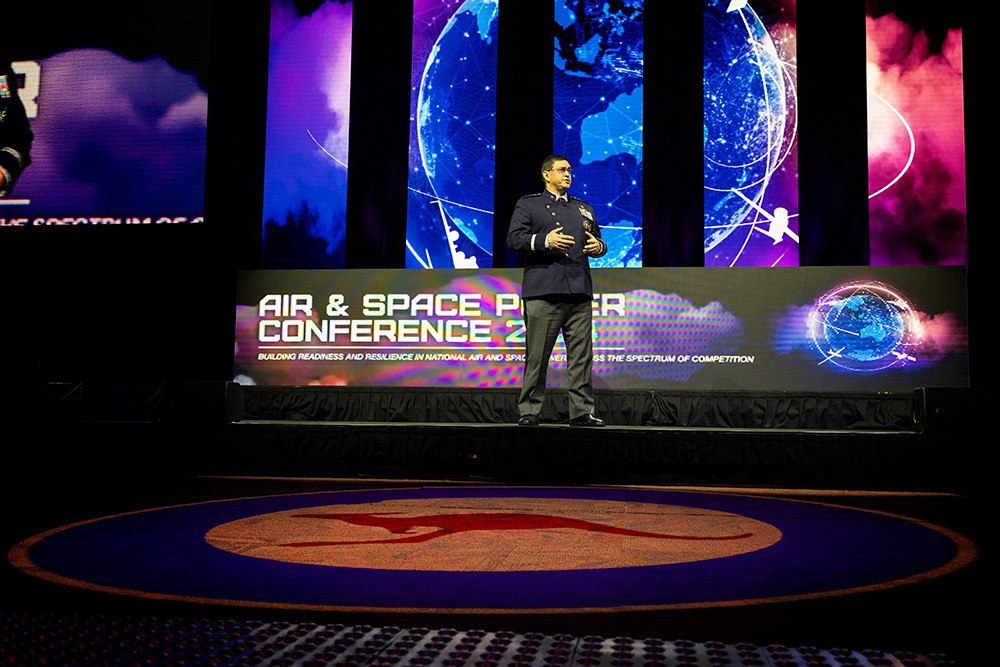U.S. Space Force Chief of Space Operations Gen. Chance Saltzman underscored the importance of the U.S.-Australia strategic partnership during the Royal Australian Air Force’s 2024 Air and Space Power Conference in Canberra, May 9.
The conference brought together members of Australia’s military forces and partners, including the U.S. Space Force, to discuss the nation’s security interests in air and space.
Saltzman’s keynote, titled Deterrence Down Under, began with a brief history of U.S. and Australian defense relations, starting with the Battle of Hamel in 1918 during World War I. In this engagement, U.S. Army infantry fought under the same command as Australian soldiers, supported by British tanks, against German positions in and around the town of Le Hamel in Northern France.
“This was the first time in history that U.S. Army troops were commanded operationally by non-American officers,” said Saltzman. “And by the end of the war, [General John Monash] said, ‘success is not measure by how high you climb, but by how many people you bring with you.’’
“I can’t think of a better vision of allies and partners than this, especially in this era of Great Power Competition.”
Saltzman continued by underscoring the importance of the partnership between the two nations and their shared interest in maintaining free and open commerce in the Pacific and around the globe.
“Today, the space domain is radically different than when I started flying satellites decades ago,” Saltzman said. “And honestly, it’s radically different than even just four years ago when the U.S. Space Force was established … It has become congested because of more launches, more satellites, more debris, and more players in the space domain.”
China’s recent developments in space have created unacceptable risks, Saltzman explained, creating a rise in competition and orbital congestion.
“Now more than ever, joint and coalition force operations depend on space capabilities and protection from space-enabled attacks—our space forces are an integral part of the joint coalition team,” Saltzman stated.
He then discussed the U.S. Space Force’s theory of success, “Competitive Endurance,” which was unveiled in 2023. This theory of success provides the service and its Guardians with a shared purpose and a common understanding of the overall strategy employed toward its objectives. It defines organizing principles, clarifies assumptions and helps identify the equipment and training needed to be effective in the domain.
An important facet of Competitive Endurance is that it requires an enhanced level of Space Domain Awareness, or SDA. The importance of this awareness drives the need for new sensors, advanced data management and decision support tools, “and most importantly, stronger partnerships with allies around the world,” Saltman emphasized.
One such partnership is AUKUS, the trilateral security partnership between Australia, the United Kingdom and the U.S, which continues to grow and develop more space capabilities, such as the Deep Space Advanced Radar Capability, which falls under Pillar II of the agreement. DARC is a 24/7, all-weather system that increases the shared ability to detect, track, identify and characterize objects deep in space, and if necessary, take defensive action.
Saltzman then touched on the enhanced space cooperation agreement signed by U.S. Space Command and Australian Defense Space Command, deepening military collaboration through force development, combined training, and professional education opportunities.
Another topic Saltzman discussed is security classification reform.
“I think one of the biggest barriers to integration has been our outdated classification policies,” Saltzman said. “Now, to mitigate that barrier, earlier this year the U.S. released an updated classification policy—one that enables us to fundamentally rethink the way we approach classification of space systems and the effects they generate.”
This policy expands access to information and reduces barriers to space integration between the U.S. and its allies, partners and commercial space entities.
Salzman closed by reiterating the goals of the AUKUS partnership in the space domain.
“All of these initiatives add to the strategic partnership between the U.S. and Australia, and they bolster our shared defensive capabilities by sending a clear message to potential adversaries—any attempt to undermine the security and stability of the [Indo-Pacific region] will be met with unwavering resolve,” he said. “A combined resolve we have demonstrated in the past, and one we will not hesitate to show in the future.”






